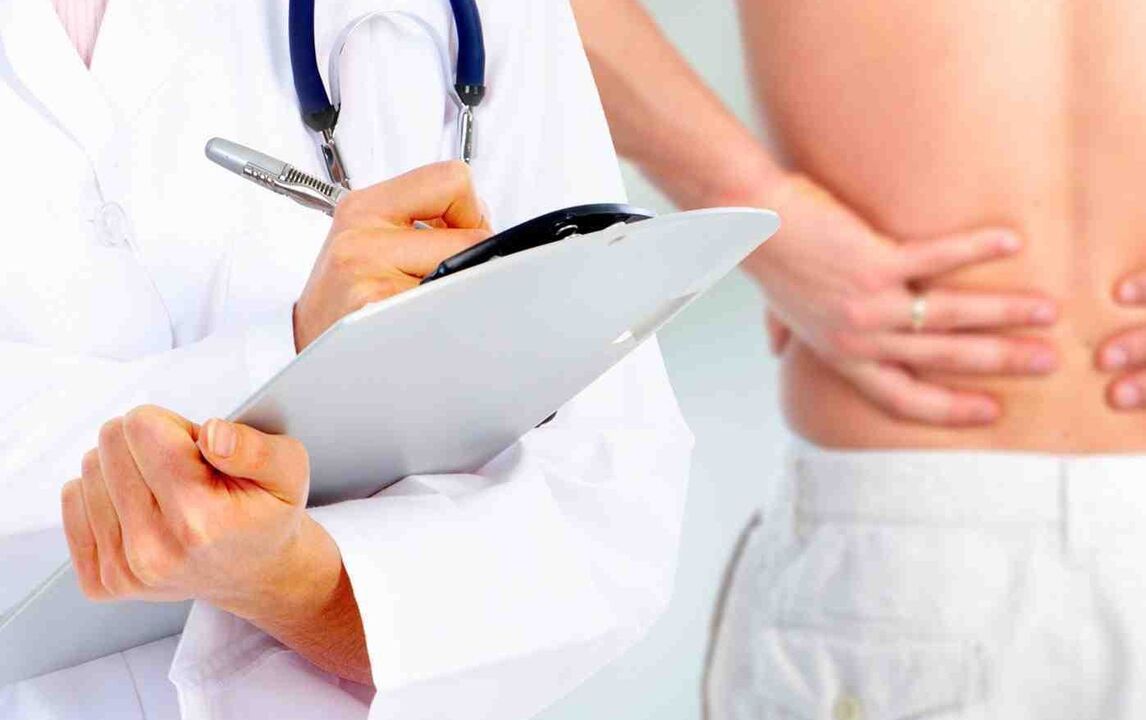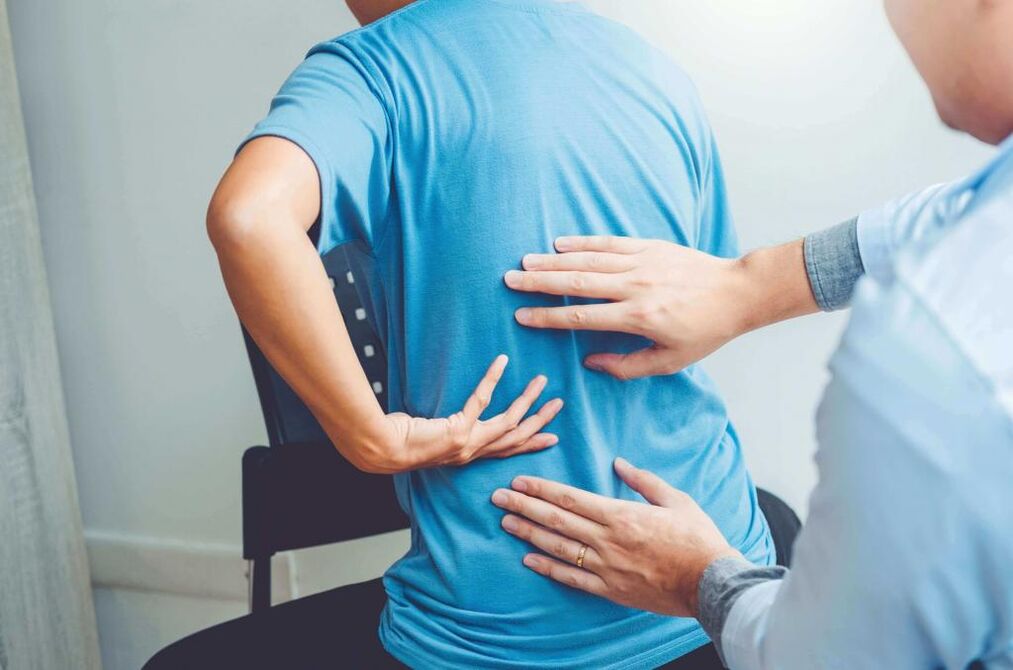So, let's consider in order the causes of low back pain syndrome:
- Spine diseases. The rarest but serious conditions that cause back pain include Bechterew's disease. With this disease, the vertebrae grow together, calcium is deposited in the ligaments, and the affected back loses mobility. Characteristic features of pain in this pathology - pain that increases at rest, when lying down for a long time; movement in the lumbar region is limited. The disease begins more often at a young age and may have a genetic predisposition.
- Curvature of the spine. Scoliosis and asymmetric scoliosis (two forms of curvature) cause spasms of the deep muscles of the spine. Usually, pain syndrome is felt in the middle and late stages of the disease, it is more pronounced at the end of the day, along with fatigue. This pathology begins in childhood and can also have a genetic predisposition.
- Osteoporosis is a condition in which the mineral density of bones is reduced, leading to fragile bones, frequent fractures.
- Osteochondrosis - thinning of the discs, which in the late stages leads to bulging and herniated discs - the most common cause of back pain. Moreover, the pain is more intense when changing positions: getting up from a sitting position, trying to lie on your stomach, turning, bending over.
- Spinal cord injuries, sprains and bruises, broken bones.
- Spondylolisthesis - i. e. displacement of the lumbar vertebra relative to the vertebra below it. The pain is localized in the mid-back, felt down the leg and accompanied by numbness and/or weakness, which is worse when standing up or bending over backwards.
- Fibromyalgia is a condition that causes pain in the muscles, ligaments, and tendons. Pain and stiffness in different parts of the body, the pain is more intense to the touch. Often patients complain of poor sleep. Most common in women 20-50 years old.
- Soft tissue and kidney damage. Severe pain due to diseased kidneys is characteristic of urolithiasis. The pain can appear in any human position. Another disease that causes discomfort in the lower back is pyelonephritis.
- Infection or infection of the spine and spinal cord, eg osteomyelitis, discitis, spinal epidural abscess. Pain from this cause is progressive, independent of the patient's position or activity. Sometimes fever or night sweats.
- Local inflammatory processes, such as appendicitis or cholecystitis.
Lower back pain is divided into three categories: local, diffuse, and reflexive. Localized pain sensation in the same place as its cause, this type of pain is most common in lower back syndromes. In this case, the most common cause is osteochondrosis of the spine, degenerative disc disease, stretching or contraction of the deep muscles of the spine.
Diffuse pain is a dull, aching pain that often radiates to the leg and it reaches the foot. This may be accompanied by osteonecrosis at the stage of herniated disc, degenerative joint disease or degeneration of the deep muscles of the spine with hemodynamic disturbances along the sciatic nerve.

Referred pain usually means that the cause of the syndrome is in the internal organs. For example, with heart disease, the arms, back, and shoulder blades can be painful. The pain is reflected from the internal organs to the lower back and is of a deep aching nature, independent of movement.
Lower back pain in men and women
In women, back pain can be the result of gynecological diseases. In this case, the unpleasant feeling is dull, pulling. Among such diseases in women - adnexitis, torsion of ovarian cysts, salpingitis, uterine fibroids and endometritis can be manifested by painful sensations in the lower back. Pregnancy, due to the increased load on the spine and the increase in body weight, often causes back pain, and they can also occur during menopause. With an ectopic pregnancy, back pain can also occur - this case is intolerable.
The causes of low back pain in men are most often due to overuse, heavy lifting, spinal injuries, but can also indicate exclusively male diseases - prostatitis or epididymitis. The pathology of the prostate gland is manifested by painful contractions, aching, frequent urination.

Diagnosis and treatment of low back pain
Depending on the cause of back pain, different specialists are involved in its treatment. If this is a pathology of the spine, then you need to contact a kinetic therapist, if it is a pathology of the internal organs, then to a therapist, gastroenterologist, gynecologist, urologist, if the pathology has a rheumatic origin then go to a rheumatologist, in the case of cancer in the lower part of the body, then to an oncologist.
First, to make a diagnosis, the doctor interviews the patient, recognizes the nature of the pain: acute or dull pain, contraction or not, depending on movement, activity, body position, Is it accompanied by other symptoms? or not. After talking, the doctor examines the patient, palpates the lumbar region, spinal muscles and extremities. Additional examination, laboratory tests, X-rays, MRI, tissue biopsies, and electromyography may be required.
To treat, also depending on the disease that uses many different means. In the case of osteochondrosis, scoliosis, spondylosis and other factors that cause spasm and inflammation in the deep muscles of the spine, commonly used analgesics and anti-inflammatory drugs, but they do not affectdirectly affects the cause of the pain syndrome, eliminating only its manifestation and having many side effects. To address the cause of back pain, the following are suggested:
- Strength decompression exercises and stretching patterns to relieve spasms of the deep muscles of the spine and eliminate pain,
- therapeutic massage to relieve tension in the muscles of the pathological area,
- cryotherapy for local pain relief,
- physiotherapeutic methods, such as shock wave therapy, acupuncture, mechanical massage, therapeutic balneotherapy (muddy application, contrast therapy, etc. ),
Back pain prevention
The main prevention of various diseases of the musculoskeletal system is to prevent the development of dystrophy, namely the weakening of the deep muscles of the spine, with nutritional conditions of the vertebrae and discsdependent. Strengthening the muscles of the spine should be regular, and the most modern way to do this is the author's method, which uses strength and decompression simulators. But the exercises can also be done without simulators, there are many of them. It is important to give rest time to exercisers at work, especially if you are sedentary type, i. e. every 3-4 hours, spend at least 15 minutes on this, onlywalk several times per week 1, 5-2. hours and performed in the morning charging.

According to the method, it is recommended to regularly perform some simple exercises to prevent back pain:
- relaxing the back (the famous exercise "Cat"): in a four-legged position, inhale - raise the head, bend the back down; exhale - lower your head, round back;
- Leg Stretch (in yoga, this is called "Pigeon Pose"): in a four-legged pose, you need to move one knee forward, foot inward and the other foot inbehind, lying prone. on your thighs, palms under your shoulders. For a more effective stretch, move your arms diagonally to the sides and lower your head, stopping for 5-10 seconds. Return to the starting position and repeat for the other side.
- lift the pelvis in the supine position with the legs bent at the knees;
- pressing: in the supine position, bend the knees and arms at the elbows, hug the back of the head, press the chin to the chest as you exhale, raise the shoulder blades;
- Knee presses: in a prone position, pull your knees in turn towards your chest, pressing your hands to your body on an exhale or doing it while hanging down.
All these exercises are very simple, just 10-15 repetitions of each exercise is enough. Just practice regularly, they will bring you invaluable benefits!
Among additional tips, a comfortable mattress can be used so that the back muscles can relax at night. If you spend a lot of time driving or working at a computer, take care of correct body posture. The car seat should be height-adjustable and close to the handlebars, and the backrest should be soft enough to avoid bumps from rough roads.
When working or studying at a table, the elbow should be bent at right angles. The chair must have a backrest to support the lower back, and the look (along with it and the neck) should be straight or slightly upward, but not downward. The light falls precisely on the work surface of the table.
Remember, prevention is more important than cure!
























